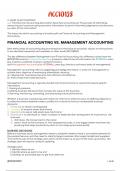Class notes
ACC1012S- Business Accounting
- Course
- Institution
ALL THE NOTES YOU WILL NEED TO PASS THE EXAM. First-year second-semester business accounting notes, all chapters start to finish. Notes made from the lecture slides, lecture videos and lecturer talking points thus making them in-depth and comprehensive.
[Show more]



